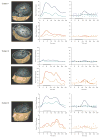Localization of load sensitivity of working memory storage: quantitatively and qualitatively discrepant results yielded by single-subject and group-averaged approaches to fMRI group analysis
- PMID: 17296315
- PMCID: PMC1994574
- DOI: 10.1016/j.neuroimage.2006.12.029
Localization of load sensitivity of working memory storage: quantitatively and qualitatively discrepant results yielded by single-subject and group-averaged approaches to fMRI group analysis
Erratum in
- Neuroimage. 2007 Jul 1;36(3):1056
Abstract
The impetus for the present report is the evaluation of competing claims of two classes of working memory models: Memory systems models hold working memory to be supported by a network of prefrontal cortex (PFC)-based domain-specific buffers that act as workspaces for the storage and manipulation of information; emergent processes models, in contrast, hold that the contributions of PFC to working memory do not include the temporary storage of information. Empirically, each of these perspectives is supported by seemingly mutually incompatible results from functional magnetic resonance imaging (fMRI) studies that either do or do not find evidence for delay-period sensitivity to memory load, an index of storage, in PFC. We hypothesized that these empirical discrepancies may be due, at least in part, to methodological factors, because studies reporting delay-period load sensitivity in PFC typically employ spatially normalized group averaged analyses, whereas studies that do not find PFC load sensitivity typically use a single-subject "case-study" approach. Experiment 1 performed these two approaches to analysis on the same data set, and the results were consistent with our hypothesis. Experiment 2 evaluated one characteristic of the single-subject results from Experiment 1 - considerable topographical variability across subjects - by evaluating its test-retest reliability with a new group of subjects. Each subject was scanned twice, and the results indicated that, for each of several contrasts, test-retest reliability was significantly greater than chance. Together, these results raise the possibility that the brain bases of delay-period load sensitivity may be characterized by considerable intersubject topographical variability. Our results highlight how the selection of fMRI analysis methods can produce discrepant results, each of which is consistent with different, incompatible theoretical interpretations.
Figures













References
-
- Aguirre GK, Zarahn E, D’Esposito M. An area within human ventral cortex sensitive to “building” stimuli: evidence and implications. Neuron. 1998a;21:373–383. - PubMed
-
- Aguirre GK, Zarahn E, D’Esposito M. The variability of human, BOLD hemodynamic responses. NeuroImage. 1998b;8:360–369. - PubMed
-
- Baddeley AD. Working Memory. Oxford University Press; London: 1986.
-
- Baddeley AD. The episodic buffer: a new component of working memory? Trends in Cognitive Sciences. 2000;4:417–423. - PubMed
-
- Baddeley AD, Hitch GJ. Working Memory. In: Bower GH, editor. The Psychology of Learning and Motivation. Academic Press; New York: 1974. pp. 47–89.
Publication types
MeSH terms
Grants and funding
LinkOut - more resources
Full Text Sources
Medical
Miscellaneous

